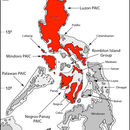en
names in breadcrumbs


Gekko mindorensis is one of ten currently recognized, endemic species of Gekko in the Philippines. This species differs from all other endemic species of Gekko in the Philippines in having a widespread distribution spanning multiple recognized faunal regions (Mindoro, Luzon, Visayan [Central], Mindanao faunal regions). Ongoing investigations suggest that this species may actually represent a complex of morphologically similar, but unique, species (C. Siler and R. Brown, unpublished data). Gekko mindorensis is currently recognized to occur throughout most islands of the Luzon, Mindoro, Visayan (Central), and Mindanao faunal regions in the Philippines, as well as numerous deep ocean islands (i.e., Lubang, Maestre de Campo, Caluya).
Recent studies and increased survey efforts throughout the Philippines have resulted in a dramatic increase in the diversity of gekkonid lizards in the country. The archipelago is now known to support ten genera and at least 48 described species in the genera Cyrtodactylus (9 species), Gekko (12–13), Gehyra (1), Hemidactylus (5; including platyurus, a species formerly assigned to Cosymbotus), Hemiphyllodactylus (2), Lepidodactylus (6), Luperosaurus (8), Pseudogekko (4), and Ptychozoon (1) (Taylor, 1922a,b; Brown and Alcala, 1978; Brown and Diesmos, 2000; Brown et al., 1997, 1999, 2007, 2008, 2009, in press; Gaulke et al., 2007; Linkem et al., 2010; Welton et al., 2009, 2010a, b; Zug, 2010).
Ten species of Gekko are considered endemic to the archipelago (Brown et al., 2009; Linkem et al., 2010) and two additional species with broad geographic distributions (G. gecko, G. monarchus) are also known from the country (Taylor, 1922a, b; Brown and Alcala, 1978; Ota et al., 1989). The ten endemic Philippine species are G. athymus, G. carusadensis, G. crombota, G. ernstkelleri, G. gigante, G. mindorensis, G. palawanensis, G. porosus, G. romblon, and G. rossi. These species represent a considerable range in body size, general appearance, and ecological attributes, but all possess the following combination of morphological traits: (1) body size moderate, with relatively long, slender limbs; (2) near complete absence of interdigital webbing or cutaneous body expansions; (3) dorsal tubercles arranged in longitudinal rows on the dorsum (except for G. athymus, in which dorsal tuberculation is absent); (4) scales of dorsum between tubercle rows minute, non-imbricate; (5) scales of venter enlarged, imbricate, flat; (6) differentiated postmentals elongate; and (7) subcaudals enlarged, plate-like (Brown and Alcala, 1978; Brown et al., 2007, 2008, 2009).
Gekko mindorensis can be distinguished from congeners by the following combination of characters (1) medium body size (SVL 55.0–88.2 mm for adult males; 68.2–70.9 for females); (2) vertebral coloration with dark, thin transverse bands; (3) supralabials 11–13; (4) preanofemorals 52–66; (5) Toe IV scansors 12–14; (6) internasals contacting rostral 1; (7) scales contacting nostril 5; (8) midbody ventral scales 40–47; (9) midbody dorsal scales 102–125; (10) midbody tubercle rows 16–20; (11) vertebral tubercles in axilla–groin distance 17–26; (12) paravertebral scales in axilla–groin distance 180–195; (13) ventral scales in axilla–groin distance 58–63.
Gekko mindorensis is currently recognized to occur throughout most islands of the Luzon, Mindoro, Visayan (Central), and Mindanao faunal regions in the Philippines, as well as numerous deep ocean islands (i.e., Lubang, Maestre de Campo, Caluya).
Gekko mindorensis, as currently recognized, occurs across multiple faunal regions in the Philippines as well as deep-ocean islands. Populations can be found on the Mindoro, Luzon, Visayan (Central), and Mindanao Pleistocene Aggregate Island Complexes.
Traditionally, Gekko mindorensis has been confused with the morphologically similar species G. monarchus. Both species often have banded morphologies, and scale and pore counts, as well as coloration and other diagnostic features are often needed to tell these species apart. They are not known to occur sympatrically, which aids in species identification in the wild.
SVL 55.0–88.2 mm for adult males; 68.2–70.9 for females
Pocanil Point, Mindoro, Philippine Islands.
The Mindoro narrow-disked gecko (Gekko mindorensis) is a species of gecko. It is endemic to the Philippines.[2]
The Mindoro narrow-disked gecko (Gekko mindorensis) is a species of gecko. It is endemic to the Philippines.